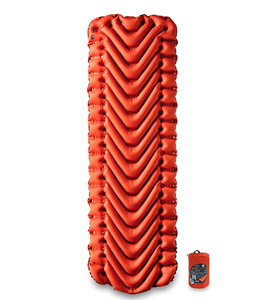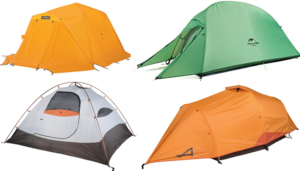A bad back crumbling your camping dreams? Well, you are not alone. And there is a very simple yet super effective solution to combat excruciating back-pain when you go out camping. Whether it’s the bone-chilling air of the mountains, the bumpy ride to the top or the rocky surface to lie on when the sun goes down, they are all key ingredients to concoct a terrible backache which could bad enough to dull your entire trip. So, what you need to pack with your camping gear is a quality camping pad.
Camping pads or mattresses are an effortless way to add a layer of insulation to keep you toasty and offer firm support to a weak back for a comfortable night of sleep, so you can wake up all fueled up ready for the fun camping activities.
With the market getting flooded with camping pads every other day, it can e quite an overwhelming experience for a newbie to pick the right one. So, here is our concise list of the best camping pads for bad backs in the market to help you make the right decision.
In a hurry? My favorite is this Coleman Self Inflating Camping Pad with Pillow. See it at Amazon.
Reviewing the Top Five Camping Pad for A Bad Back
Therm-a-Rest NeoAir Xlite Ultralight Backpacking Air Mattress – the Lightest of the lot
When it comes to lightweight camping pads that one carry in their backpack without even feeling it, this beauty wears the crown. Weighing a tad above half a pound, this air mattress employs over a hundred cells of air to maintain equalized air distribution. Resultantly, one gets incredible stability and uniform support to brace their back.
Moreover, it is integrated with a Patented Triangular Core Matrix which is sandwiched between alternating layers of air and foam. This protects you from the cold hard ground and preserves your body heat for a warm and comfortable night of sleep.
Pros:
• A firm and uniform support
• Ultra-light
Cons:
• Some complaint of its cacophonous nature during movement.
Coleman Self Inflating Camping Pad with Pillow – for when you are on a tight budget
A plush, tufted cushioning with a thickness of about 2.5 inches gives you a luxurious snooze even in the middle of the wilderness. While the durable polyester sheath that envelopes the beauty inside ensures longevity even with rough use prevalent among frequent campers. To add to the comfort, it comes with its own pillow, so you don’t have to depend on scrunched up clothes or your backpack to rest your head at night.
An integrated free-flow valve plumps up the pad without calling for a bulky air pump within minutes. Whereas the built-in compression straps make deflation effortless making this a boon for those with backaches.
Pros
• Budget-friendly
• Decent real estate
Cons
• Fastening straps can trouble some users
Exped MegaMat Duo 10 Self Inflating Sleeping Pad – for when your bone freezes
Love to camp amidst snowcapped mountains? Well, this gem is just the right option for you with its smart Bluesign-certified insulation which will keep you toasty even when the temperature drops beyond -54 degrees Fahrenheit.
It gives you a significant 3.9 inches of lift from the freezing ground while offering cushiony soft comfort for you to slumber like a baby.
Pros
• Extra air pumped in can add more firmness for better back support
• Made out of Hydrolysis-resistant material
Cons
• An expensive investment
WELLAX Ultra Light Sleeping Pad – the most comfortable camp pad
This camp pad from the house of Wellax is studded with a plethora of air packed cells that act as cushions to ensure cushiony comfort as well as springs to give your back the much-needed support throughout the night.
The unique design also ensures that weight is distributed uniformly throughout the entire pad, so there is no sinking and bunching with body movement. It is also a cakewalk to inflate it completely with just a few breaths.
Pros
• Uniform support even with movement
• Easy inflation and deflation
Cons
• Not ideal for camping at super cold areas
Klymit Static V Lightweight Sleeping Pad – the most innovative design
The Klymit sleeping pad was love at first sight for us because of its utter cool (for the lack of a better word) “V chamber” design. Interestingly, its unique design does more than just attracting eyeballs; it is a smart mechanism to limit air movement and heat loss. In addition to that, its body mapping technology ensured that the pad molds to your unique body structure to give you customized support and comfort.
Pros
• Easy inflation and deflation
• Durable material
Cons
• Insulating properties have room for improvement.
Tips and Tricks to Pick the best Camping Pad
• Foam pads like the one in Exped MegaMat Duo 10 Self Inflating Sleeping Pad is a better option for those with a bad back than air-filled mattress. However, the R&D department of the above-mentioned air-filled mattresses has done an undeniably impeccable job to create the best backpacking sleeping pad for a bad back.
• Self-inflating and deflating pads like Coleman Self Inflating Camping Pad with Pillow cuts down camping efforts by a significant volume – a boon for bad backs!
• A thickness of at least 2.5 inches is absolutely vital to keep you shielded from the rocky surface of the ground and preserve your body heat from escaping while keeping the cold of the ground from infiltrating while you snooze.
• The weight of the mattress becomes even more significant when a bad back is involved. It is vital to pick a lightweight option like the Therm-a-Rest NeoAir Xlite Ultralight Backpacking Air Mattress. This ensures that your back is stressed from the weight of the mattress sitting in your backpack.
• Consider your height and the size of the pad before spending your money. It should be large enough to accommodate you comfortably with some empty space around.
Frequently Asked Questions
What should be the thickness of a camping pad for a bad back?
A minimum 2.5″ of thickness is necessary for an individual who has a bad back. Preferably go for 3-4″ if the investment is not an issue. Having the above-mentioned thickness will ensure a comfortable night’s sleep and easy movement on the pad if required.
What size pads are comfortable for an individual with a bad back?
Being the widest parts, hops and shoulders must comfortably fit on the pad. 25″ wide pads are more comfortable than 20″ regular pads because they ensure that an individual’s body parts do not touch the ground while sleeping or movement.
Why foam pad is better than air pad if an individual has a bad back?
Foam pads are known to give more even distribution when an individual is sitting or sleeping in comparison to air pads. Air pads can also be used for a bad back individual, but he/she should select a supportive air pad with coil support.
Conclusion
In conclusion, we cannot stress the importance of the best camping pad for back pain. It is not just an investment for a better camping experience but an investment for the health of your entire body. So, go now that you know your best options, pick one that suits your needs the best.

































